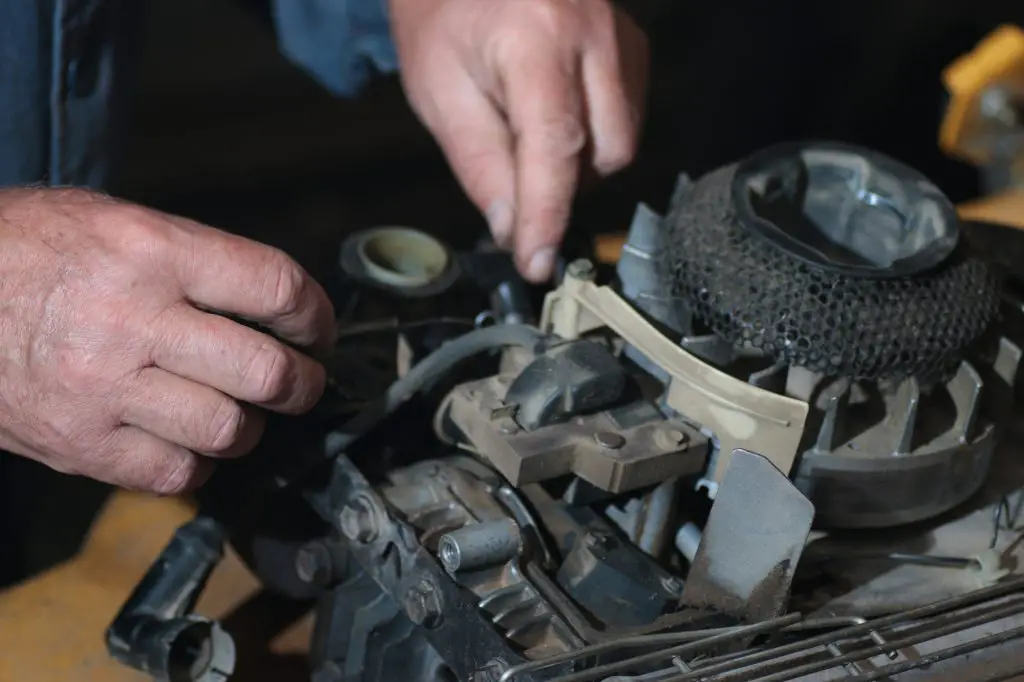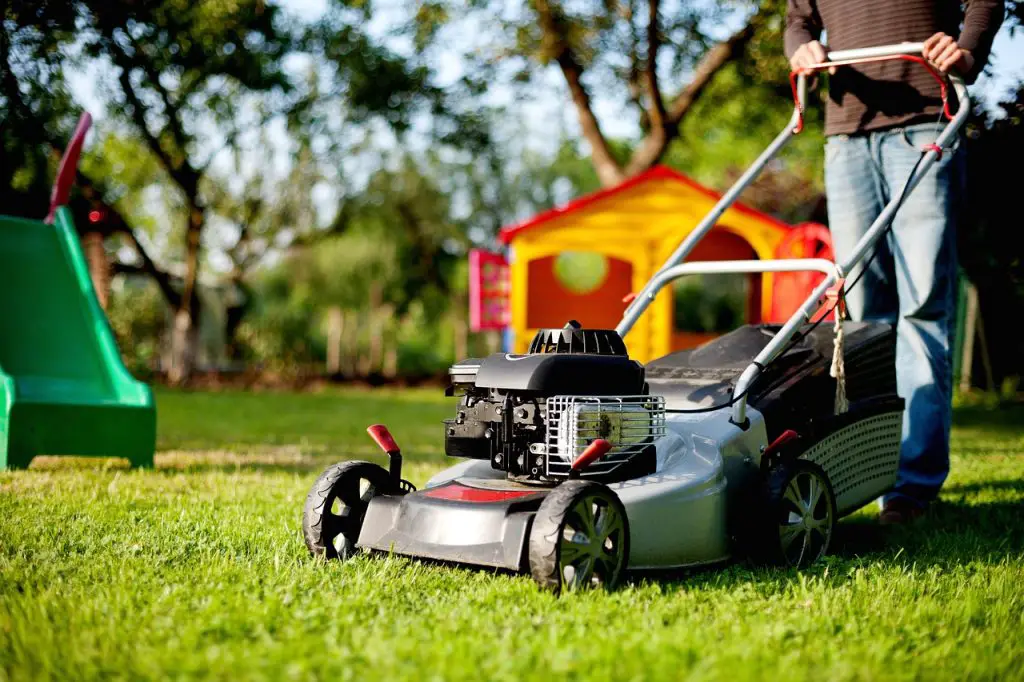Fuel pumps are an essential component of lawn mowers. Sometimes lawn mower fuel pumps go bad. But how do you know if your lawn mower fuel pump has gone bad?
Signs of a bad lawn mower fuel pump include unusual fuel tank noises and engine troubles such as sputtering, surging, and stalling. To test the pump, remove the pump’s outlet hose, siphon the fuel, and start your lawn mower. If fuel fails to flow in a consistent stream, then the fuel pump is bad.
In this content you’ll learn:
Terms To Know
You can find more detailed and technical information below. However, here are some terms to give you a head start on understanding what you’ll find there:
- Fuel pump: pumps fuel from the fuel tank to the carburetor
- Fuel tank: contains the fuel for a lawn mower
- Carburetor: ensures the proper mixture between fuel and air
- Diaphragm: helps regulate fuel flow from the carburetor
Understanding The Role Of A Lawn Mower Fuel Pump

Manufacturers mount fuel pumps on the side of the motor, between the fuel tank and the carburetor. The fuel pump’s job is to ensure an even fuel flow to the carburetor, which is mounted on top or to the side of the motor. The pump is either mechanical, using the pressure created inside the motor to move the fuel, or an electric one powered by the battery.
The fuel tank is usually a large black or white plastic tank located on the side or the top of the engine in push lawn mowers. It has a large 1-inch to 2-inch black cap with a gas symbol on the top. Ride-on lawn mowers have their gas tanks located either under the seat at the rear or on either side of the control panel, just ahead of the driving position.
On a more technical level, the fuel draws its power from the pressure created inside the lawn mower’s crankcase. The crankcase is the body of the motor that houses the crankshaft, connecting rods, and other parts on the bottom half of the motor. It also holds the oil that lubricates the motor, which you’ll want to make sure you keep an eye on and maintain appropriately as well.
As the piston moves up and down through its power stroke and exhaust stroke, it creates negative pressure on the up stroke and positive pressure on the down stroke.
A rubber hose at the top of the crankcase transfers the pressure to the fuel pump. The changes in pressure cause the diaphragm inside the fuel pump to move backward and forward, which pumps fuel to the carburetor.
One side of the pump has an inlet where fuel enters from the fuel tank. The other side of the pump has an outlet through which the fuel pumps to the carburetor.
Why Do Lawn Mower Fuel Pumps Go Bad?
Fuel pumps usually fail because the diaphragm becomes worn or perforated, causing unusual noises. But your fuel pump may also fail due to the following:
- Old age
- Pumping fuel that’s old or contains dirt or moisture
- An electrical fault
- A clogged fuel filter
- Tears or a hole in the fuel line
- A fuel line restriction
Signs Of A Failing Lawn Mower Fuel Pump

A failing lawn mower fuel pump shows many signs; these range from strange fuel tank noises to engine issues.
Let’s begin with the fuel tank.
Unusual Noise From The Fuel Tank
A properly functioning fuel pump slightly purrs. If you hear the fuel tank whining or vibrating, it could indicate a damaged fuel pump. However, this could also indicate a blocked fuel line, constricted fuel filter, or bunged-up carburetor.
Keep this in mind and look for other issues as described below to help confirm if your lawn mower fuel pump has gone bad.
Difficulty Starting The Engine
Diaphragm fuel pumps are self-priming. A self-priming fuel pump means you don’t have to manually run fuel into the fuel line and remove water vapor. The pump does this for you, making it easier to start the engine.
If the fuel pump delivers either too much or too little fuel, it will make starting the engine difficult or impossible. Typically, your lawn mower should start after a few cranks of the starter or pulls on the starter cord.
A Sputtering Or Stalling Engine
When your lawn mower sputters or stalls, it usually indicates the carburetor is not providing a constant fuel flow to the engine.
As the fuel pump operates, it provides a constant fuel flow to the carburetor under a certain pressure. The carburetor delivers the fuel to the engine via jets in the throttle body. As the fuel in the carburetor float bowl is used, the float drops, causing a valve to open and more fuel to enter the float chamber under pressure from the fuel pump.
Power Loss And Surging Power
As the fuel pump fails, it contributes to a loss of power. When the pump diaphragm wears out, the fuel pump becomes less efficient at moving fuel into the carburetor.
You will notice this as you struggle to get the lawn mower to work normally. If it’s a push lawn mower, the blades will bog down more easily, and you’ll struggle to cut damp or thicker grass (but that could also be due to needing to replace or sharpen the blades). On ride-on lawn mowers and self-propelled lawn mowers, you will struggle to get the lawn mower to move up inclines or through thick grass and soft sand.
The inconsistent fuel flow to the carburetor will cause the engine to surge as it tries to maintain momentum. Instead of receiving the same amount of fuel on each power stroke, the engine will have too much or too little fuel, resulting in bursts of power followed by a lack of it. The lawn mower may backfire as the excess fuel is pushed into the hot exhaust system and ignites.
Decreased Fuel Efficiency
As the fuel pump malfunctions, it can cause fuel to leak out of the pump body. Aside from the leakage, it will also cause the lawn mower to run erratically.
This issue usually ends up with the engine using more fuel as it struggles to maintain power. If the diaphragm has a hole or a tear, fuel can run into the engine via the vacuum hose. Apart from wasting fuel, this also causes damage to the engine as it reduces the efficiency of the lubrication inside the engine.
Complete Engine Failure
Once your fuel pump fails, your engine will stop. No matter how much you try to start it, fuel will not reach the carburetor.
This issue will require a fuel pump replacement, or you may be able to obtain a rebuild kit to recondition your fuel pump. However, if your fuel pump has been malfunctioning for some time, it could have caused excessive wear and tear inside the engine, causing it to seize.
This is especially true if the fuel ends up inside the crankcase. This issue requires an engine overhaul, as the pistons will likely be beyond repair. In the worst-case scenario, the lawn mower will be beyond repair, or the cost will be more than purchasing a new lawn mower.
Testing And Diagnosing A Bad Lawn Mower Fuel Pump
When your lawn mower starts showing one or more of the symptoms above, it’s time to test whether or not your lawn mower fuel pump is the culprit. To do so, follow the below systematic process (one of several ways to drain fuel from a lawn mower), beginning with removing the outlet hose from the fuel pump.
Safety Precautions
As with any lawn mower maintenance, practicing safety first is essential. The safety process includes placing your lawn mower on a flat surface. Also, ensure the space is well-ventilated, such as a garage.
Tools Needed
To perform the below operations, you’ll need a variety of tools, which include:
- A screwdriver
- Pliers
- Fish tank tubing
- Safety gloves
- Safety glasses
- A fuel can
- Rags (for cleaning up any spills)
- A wrench
- Large funnel
- A fire extinguisher (in case of a fire emergency)
- Wheel chocks (only necessary if you raise or tilt your lawn mower)
1 – Check To See If Your Lawn Mower Even Has A Fuel Pump
To determine if your lawn mower fuel pump is bad, you must first check to see if your lawn mower has one. Manufacturers only fit fuel pumps to lawn mowers with carburetors mounted above the fuel tank. You can identify a carburetor by the black fuel line running to it and the linkages connected by a cable to the throttle or accelerator.
2 – Remove The Outlet Hose From The Fuel Pump
The outlet hose leads to the carburetor. Loosen the clip holding the hose in place and use a flathead screwdriver to lever the hose off the pump carefully.
3 – Attach Some Tubing To The Fuel Pump Outlet Pipe
Use 6mm fish tank tubing and funnel to direct the fuel into a container. This way, you will not waste any fuel during this process.
4 – Start Your Lawn Mower
The carburetor will have sufficient fuel to allow the lawn mower to run for about a minute. The fuel should run down the tubing and into the container during that time. If it does not or if there is only a trickle of fuel, then you know the fuel pump is faulty.
If plenty of fuel is coming down the tubing, then the fuel pump is working fine, and you should look to the fuel filter or carburetor as the cause of the problem.
5 – Check The Breather Hose Connecting The Fuel Pump To The Crankcase
A part that commonly causes your fuel pump to malfunction is the breather hose. If this is the only problem, your fuel pump will work properly once you fix or replace the hose. This is because the breather hose provides power to the fuel pump, and any tears or damage can cause the pressure to bleed off.
To get at the hose, you’ll need to locate it first. Conveniently, the breather hose is located underneath the fuel pump and requires you to remove the two bolts holding the fuel pump in place.
Once you remove the bolts, pull the hose off the end of the pump. Gently pull the hose off the crankcase. It is held in place by an enlarged piece of rubber at the end of the hose. Check the hose for holes or tears.
After replacing the hose, connect the pump and repeat step three to see if you fixed the problem.
6 – Replace The Fuel Pump
If the fuel pump is still not working correctly, you can try fixing it, but it’s better to buy a replacement. Most pumps are made of plastic, either white or black. Buy a manufacturer’s pump, as cheap pumps are prone to failure or may not work properly when installed.
To replace the pump, unbolt it from the lawn mower’s body and remove the clips holding the hoses in place. Gently ease the hoses off the pump with a flathead screwdriver.
Attach the new pump to the breather hose first, then bolt it. Then remove any end caps on the hose and push the inlet and outlet hoses into place.
Ensure you put the pump on the right way so the inlet and outlet are aligned correctly. Arrows show you which way the fuel flows. Make sure they point in the direction of the carburetor.
Quick Tips To Properly Maintain Your Lawn Mower Fuel Pump
The fuel pump works more efficiently if plenty of fuel is in the tank. If the fuel sloshes inside the tank, it may allow some air into the fuel line, which can place additional stress on the diaphragm.
Also, use the correct fuel grade for your lawn mower. Check your owner’s manual to see what fuel grades the manufacturer recommends. Also, avoid running old fuel through the fuel pump, as it can cause the pump to gum up over time.
It is common for sludge to build up in the bottom of your fuel tank (cleaning it helps). To avoid this, keep a check on your fuel filter. If it appears dirty, replace it to avoid contaminated fuel entering the pump. Debris can block the pump’s narrow passageways.
Conclusion: How To Know If Your Lawn Mower Fuel Pump Is Bad
Fuel pumps are integral components that ensure your lawn mower runs appropriately. If you suspect your fuel pump is bad, you should check it using the methods we suggest above to avoid damaging your engine, and then take steps to fix or replace it.
So, do you think your lawn mower fuel pump is bad? Are you seeing the same signs above? Let us know what’s going on in the comments below!

